M11 is one of the most famous open star clusters. It is located in the small constellation of Scutum right in the heart of the Milky Way. Normally this would make the cluster rather hard to separate from the background but M11, listed as Trumpler I2r stands out strongly thanks to its high star density. Many open clusters have a couple hundred stars or fewer only a few dozen that they eye sees in a typical scope. But this cluster has about 3000 stars of which 500 are magnitude 14 or brighter and thus seen in an 8 to 10" scope. Even a smaller scope sees a few hundred stars not a dozen or so of many clusters. WEBDA puts it about 6100 light-years distant so it stands in front of most of the stars of the Milky Way in Scutum which I find to be nearly twice that distance on average. It's most massive stars are listed at spectral type B8 meaning it is a rather young cluster. WEBDA puts its age at just under 200 million years. Being young most of its blue stars B8 and less massive are still on the main sequence so the cluster is quite blue even if it is reddened by 0.426 magnitudes according to WEBDA. I didn't try to compensate for that in my image.
Like many of my Messier object images, this one was taken before I really knew what I was doing. In an attempt to better show off the cluster I limited exposure time to only 10 minutes. This does bring out the cluster but it loses the fainter members of the cluster at the same time. I now have ways of doing this via processing that keeps these fainter stars. Also at the time, I was only using G2V color balancing which doesn't do well for dust reddened images. Still, it looks close enough considering the minimal exposure time so I didn't reprocess it in any way from my hack job back in 2007. Instead, it is on my reshoot list which may or may not happen. It is displayed at 1.5" per pixel rather than my normal 1" per pixel.
The cluster is thought to have been first seen by Gottfried Kirch in 1681 though he didn't see any of its stars showing his scope to be rather poor. William Derham is the first known to see stars in it sometime around 1733. Charles Messier recorded it on May 30, 1764.
For more see: http://messier.seds.org/m/m011.html
14" LX200R @ f/10, L=5x2' RGB=3x2', STL-11000XM, Paramount ME | 
M11L5X2RGB3X2_67%.jpg
| M12 is yet another globular star cluster in Ophiuchus. This constellation hosts more globular clusters than any other. It is some 15 to 16 thousand light-years from us. Rather close as globular clusters go. Assuming this distance and a size of about 16 arc minutes it is some 75 light-years across. Though I measure its size at 12 arc minutes on my image making it only 56 light-years across. But then my exposure time was very short, only 10 minutes rather than my usual 40 meaning I lost a lot of the outlying stars. Why I used such little exposure time I don't know recall and I left no notes.
The cluster was one actually discovered by Messier himself on May 30, 1764. For more on it see: http://messier.seds.org/m/m012.html
14" LX200R @ f/10, L=5x2' RGB=3x2', STL-11000XM, Paramount ME | 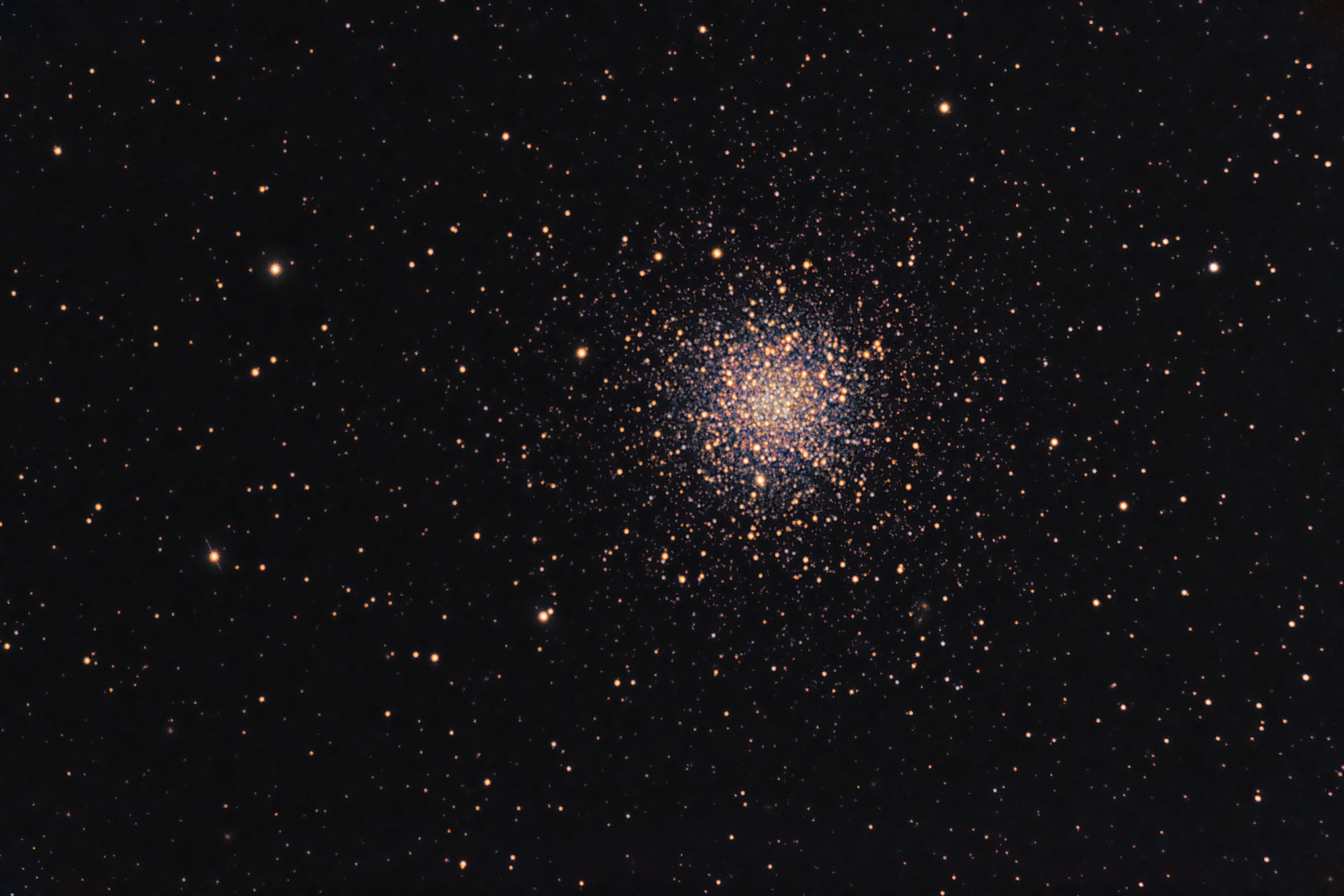
M12L5X2RGB3X2R.JPG
| M13 is likely the most famous globular cluster in the northern hemisphere. A combination of its large true size of just under 150 light-years, nearly half again the size of a typical globular cluster and its rather close distance of 25,000 light-years make it the largest globular in the northern sky. The southern sky has two even larger, so large they were both originally cataloged as stars.
M13 was discovered by Edmond Halley in 1714. Charles Messier recorded it on June 1, 1764. Its age is often stated as older than the universe which is impossible of course. Safe to say it is very old and may predate our galaxy's formation. That would mean it was captured from another galaxy ours likely disrupted in its early days.
You can read more on this at: http://messier.seds.org/m/m013.html
As with most M objects, I took this one back in 2007 when I didn't quite understand what I was doing and my processing skills were rather poor. Since this one turned out fairly well I've not reprocessed it though it could use this treatment.
14" LX200R @ f/10, L=6x5' RGB=2x10', STL-11000XM, Paramount ME
| 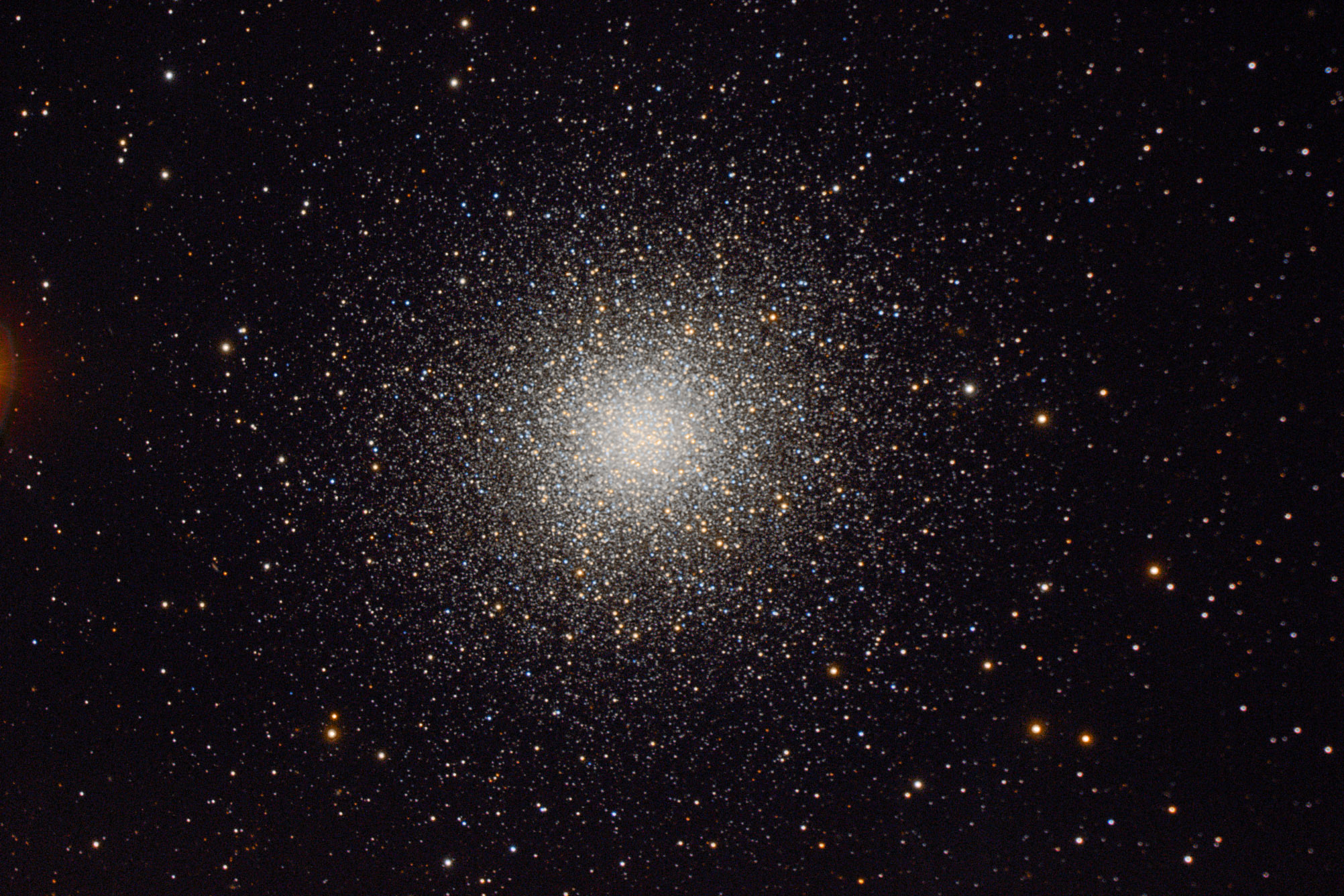
M13LUM6X5RB2X10G1X10R2.jpg
| M14 is a rather typical globular cluster, class VIII, in Ophiuchus. Being a bit below the celestial equator and in the edge of the Milky Way it is a bit difficult for me to image clearly. Dust from the galaxy seems to have reddened my image considerably. I reprocessed it to correct for this using eXcalibrator so hope it is more accurate than before. Searching the web for images I find some red like my original one, some that match my "corrected" version and others far bluer than mine such as this one with a 0.9 meter telescope by the pros https://www.noao.edu/image_gallery/html/im0836.html . Which is right? Who knows. I'm going with mine for now.
Distances and size of the cluster vary. Most however say it is about 30,000 light-years distant. Using that and trying to estimate its outer faint stars I get a size of 105 light-years. Rather typical but NOAO in the link above says 72 light-years for its size. Using their distance of 29,000 light-years and just the star-ball I get a size of only 55 light-years. They give it a size of 11.6 minutes of arc which I compute to give a size of 97 light-years at their distance, not 72. Time to break out the Jack Daniels.
The globular does have more variable stars than most though no where near the record for them. It was discovered by Charles Messier who listed it on June 1, 1764. Exactly when he first saw it I was unable to determine but he usually recorded his discoveries rather quickly, but for say M110 which he never recorded but is credited with finding.
This was another early image of mine that short changed the exposure time though for globular clusters this isn't all bad but did leave me with a lot of noise to deal with when I reprocessed it.
14" LX200R @ f/10, L=6x5' RGB=3x5', STL-11000XM, Paramount ME | 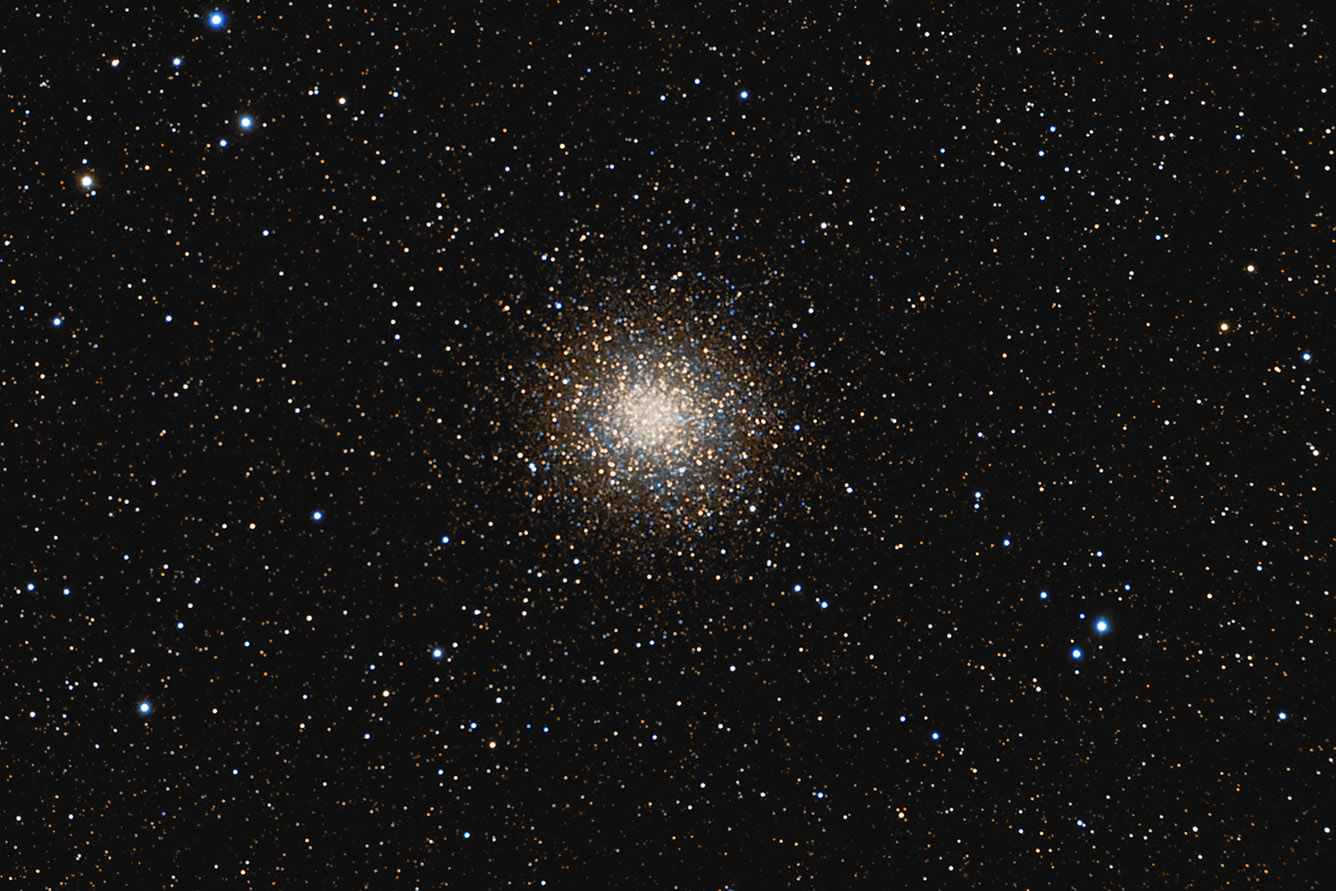
M14_6X5RGB3X5R-67.JPG
| M15 is a large, core collapse, globular cluster in Pegasus. Often described as the fly on the horse's nose because of its location. A core collapse globular is one in which the massive stars have all fallen toward the core of the globular making it unusually dense. My image has used a radial filter to tone down the core so individual stars can be seen. For a version that hasn't done this to the extent I did is at: https://apod.nasa.gov/apod/ap131119.html
The cluster is some 35,000 light-years distant by current literature though older reports put it very slightly closer.
It is home to a planetary nebula, Pease 1. In fact, it is the first planetary nebula ever found in a globular cluster though others are now known but not in any Messier globular that I'm aware of. My seeing the night this was taken wasn't all that good but you can just make it out as a blue object to the northeast of the core. The southern part is bright and starlike in my image while a shell to the north shows as a much fainter blue region. The enlarged cropped image of the core points to both parts of the nebula. I really do need to take this one on a better night. But since this dates back to 2006 and it hasn't happened again don't hold your breath.
The cluster was likely first seen by Jean-Dominique Maraldi on September 7, 1746 while he was searching for De Chéseaux' comet. Messier then cataloged it on June 3, 1764. Maraldi described it as a nebulous star...composed of many stars. So did he see it as stars or not. Most vote he didn't but was just thinking the light was likely made of many stars too faint for him to see. Messier definitely didn't see its stars. Most credit William Herschel for that.
You can read a lot more on this cluster at: http://messier.seds.org/m/m015.html
14" LX200R @ f/10, L=9x2'x1 RGB=2x2'x2, STL-11000XM, Paramount ME Related Designations for M015MESSIER 015, NGC 7078, 2MASXi J2129571+121004, 2MASS J21295836+1210007, IRAS 21274+1156, IRAS F21275+1156, LEDA 2802701, PN G065.0-27.3, PSR J2129+1210, RX J2129.9+1209, 1RXS J212958.4+120959, MAXI J2129+121, 2PBC J2129.9+1210, PBC J2129.9+1210, SAXWFC J2130.0+1209.7, 1WGA J2129.9+1210, 4U 2127+119, XSS J21296+1208, SWIFT J2129.9+1209, RX J2129.9+1209:[BEV98] 001, [KRL2007] 386, [LM2010] 51, [TES2010] 191, [ZGV2011] 008, [BTM2013] 1113, M015, PNPS1, | 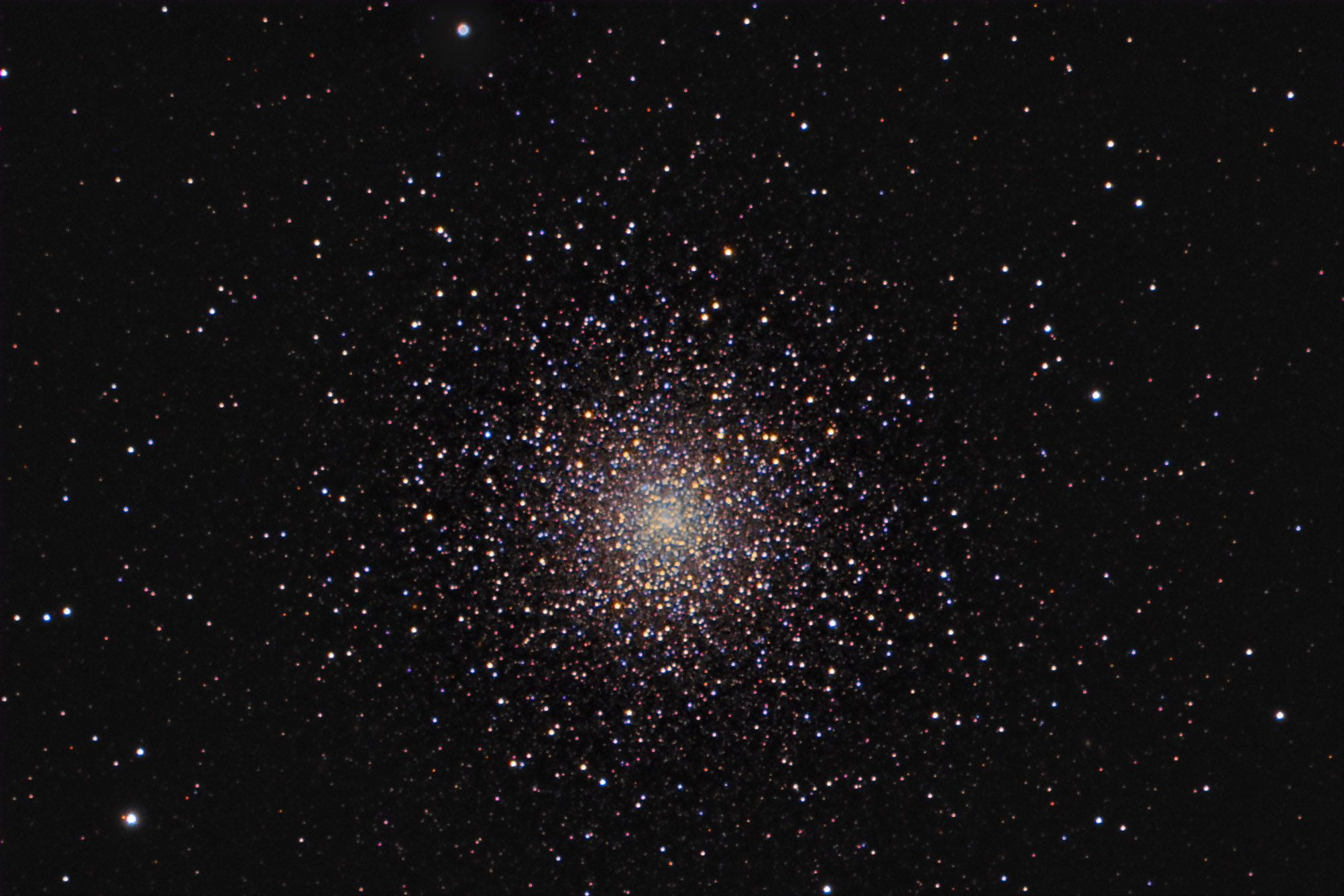
M15L9X2X1RGB2X2X2R1.JPG
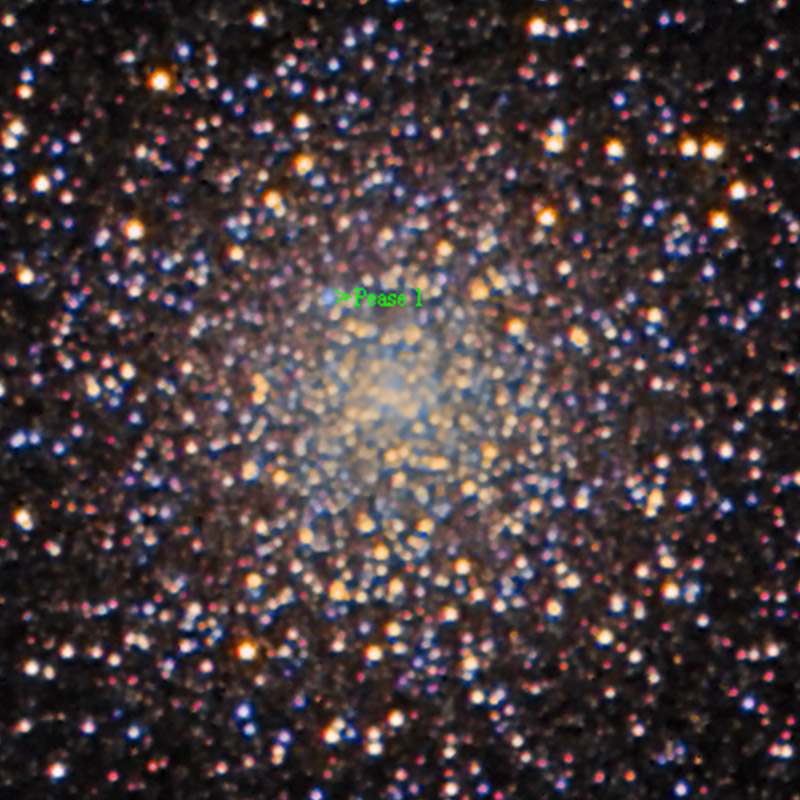
M15L9X2X1RGB2X2X2R1_PEASE1.JPG
| One object that had escaped my digital efforts until now is SH2-49, also known as GUM 83, IC 4703, NGC 6611, LBN 67, the Star Queen and, oh yes, M16 or the Eagle Nebula. What a tower of babble we've created. SIMBAD lists 11 other designations but I'll stop here.
For such a well known object I found its distance to be rather vague. NASA says 6,500 light years, Wikipedia says 7,000 and WEBDA, an authority for star clusters, says the cluster is 5,700 light years distant and some 7.7 million years old. The nebula is famous for its EGGs (evaporating gaseous globules) that form the famous "Pillars of Creation". They are the dark columns rising through the nebula and pointing to the star cluster at the top. The UV light from these super hot stars is creating them by evaporating and blowing away the dust and gas of the protostars being created at the very top of the columns. This will keep the stars from being as massive as they'd become without the star cluster's light to blow away their birth cloud before their gravity will pull it all into their surface.
This object is at -14 degrees so very low in my skies. Summer skies are unsteady low over the lake making it nearly impossible for me to get a clear view. I've tried all 7 years I've had the observatory but haven't been able to get a decent image. This was my 7th annual attempt and best of the bunch so am finally going with it though I'm not all that happy with it. I only have a one hour window this low before it moves into the meridian tree. This plus bad seeing most of the time this low makes it a nearly impossible target. I got lucky with two nights in July getting 4 L frames the best night along with one red and one blue frame. I got the remaining color frames the second night along with one L frame. I didn't get the L data I wanted as seeing wasn't holding so I switched to color both nights. Never had a usable night after that for more L or color data. I had to go with what those two short nights gave me.
This is the first of 10 deep sky objects I was able to capture in July, few very well, unfortunately. Due to the poor seeing, I've included an image downsized to 1.5" per pixel as well as my usual 1" per pixel image.
SEDS info: http://messier.seds.org/m/m016.html
14" LX200R @ f/10, L=5x10' RGB=2x10', STL-11000XM, Paramount ME | 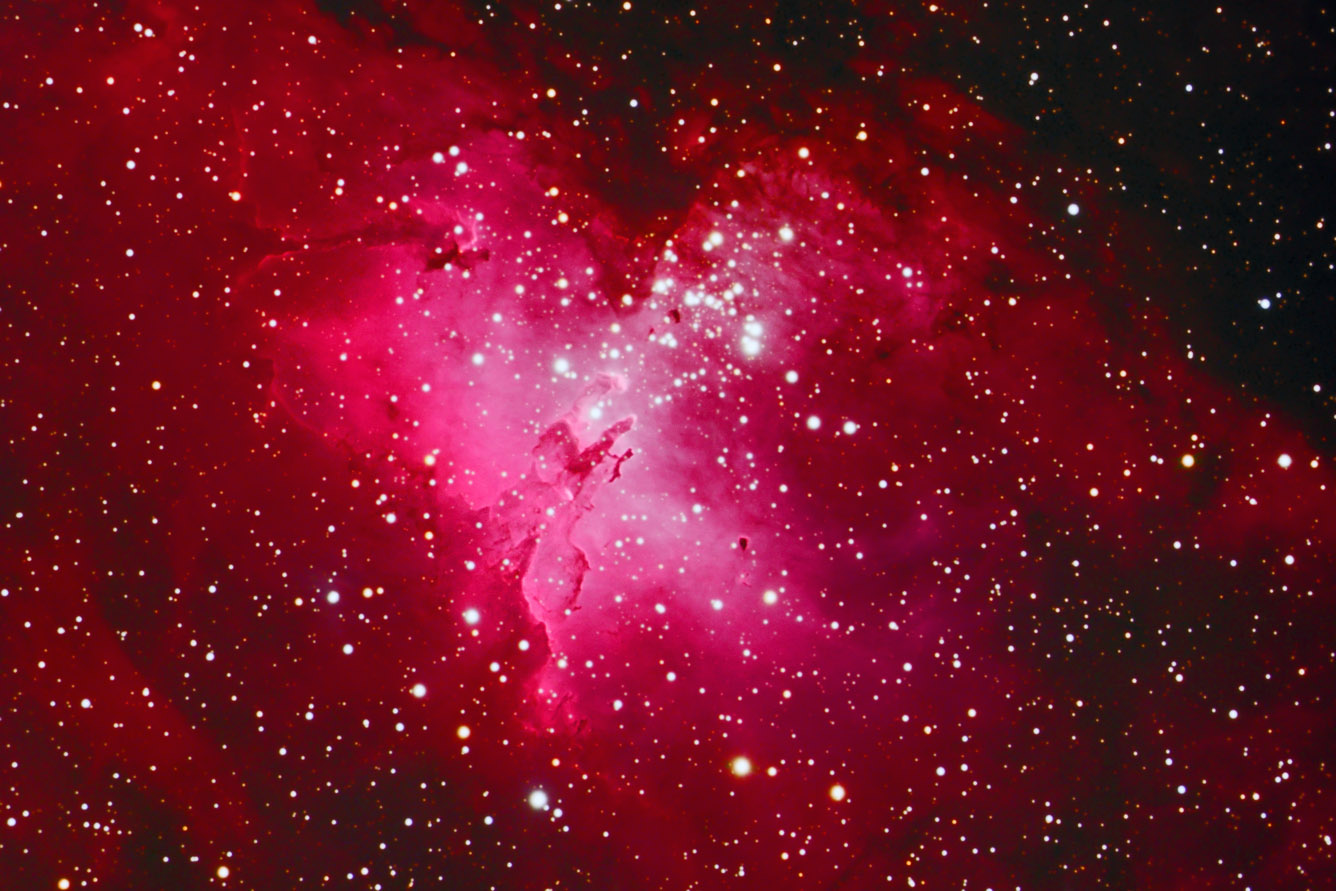
M16L5X10RGB2X10R1-67.JPG
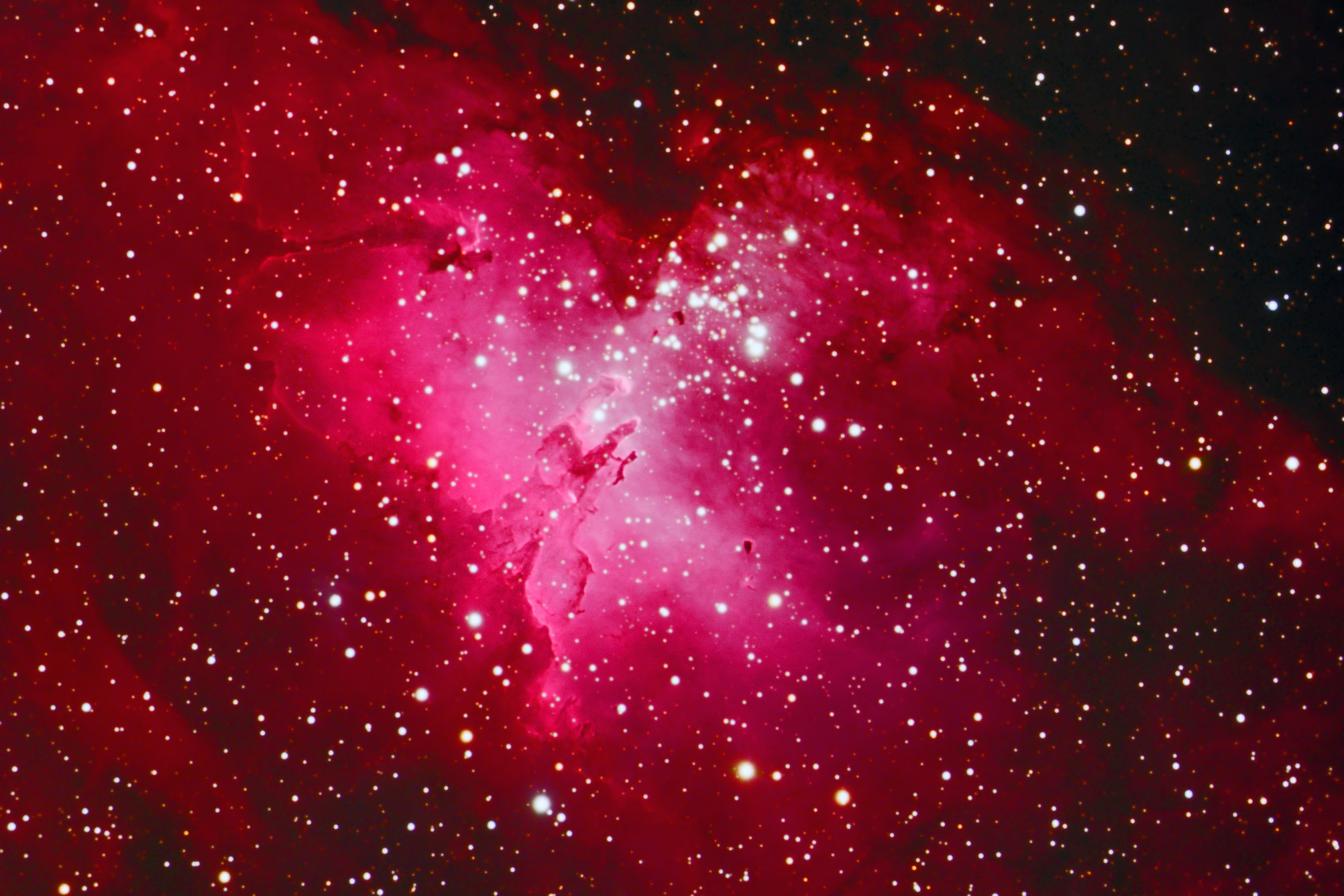
M16L5X10RGB2X10R1.JPG
| M17 is a Nebula in Sagittarius that is below my -15 degree cut off but I hadn't made that "rule" in 2006 when this was taken. The Nebula goes by many names including Swan Nebula, Horseshoe Nebula and even Lobster Nebula (mostly by southern hemisphere folks). It is thought to be about 5000 light-years away. It is one of many star-forming regions seen in this part of the Milky Way, that is, looking toward the galaxies core. Others are M16, M20 and M8 to name a few, most too far south for me to catch but as fuzzy blobs as seen from this far north.
This was a very early attempt at color processing a nebula. I had no idea how to do it and found an online tutorial that I tried to follow but came up with a very blue nebula. I found another that gave me a totally red nebula. Both very wrong compared to online images of the time. Turns out those videos were by less than major imagers and left me with poor color. For this version, I've mixed the two at about 50-50 and the color of the nebula is a good match to today's RGB images of the nebula. The blue region is rich in OIII and H beta light and is what is seen through an eyepiece as the eye is very insensitive to H alpha red but very sensitive to OIII and H beta.
Stars, however, are very poor as to color. I do need to reshoot this one now that I understand all the mistakes made in taking color data back in 2006 and 2007.
The nebula was discovered by Philippe Loys de Chéseaux in 1745. Messier recorded it on June 3, 1764.
For more see: http://messier.seds.org/m/m017.html
14" LX200R @ f/10, L=12x5' RGB=3x5', STL-11000XM, Paramount ME | 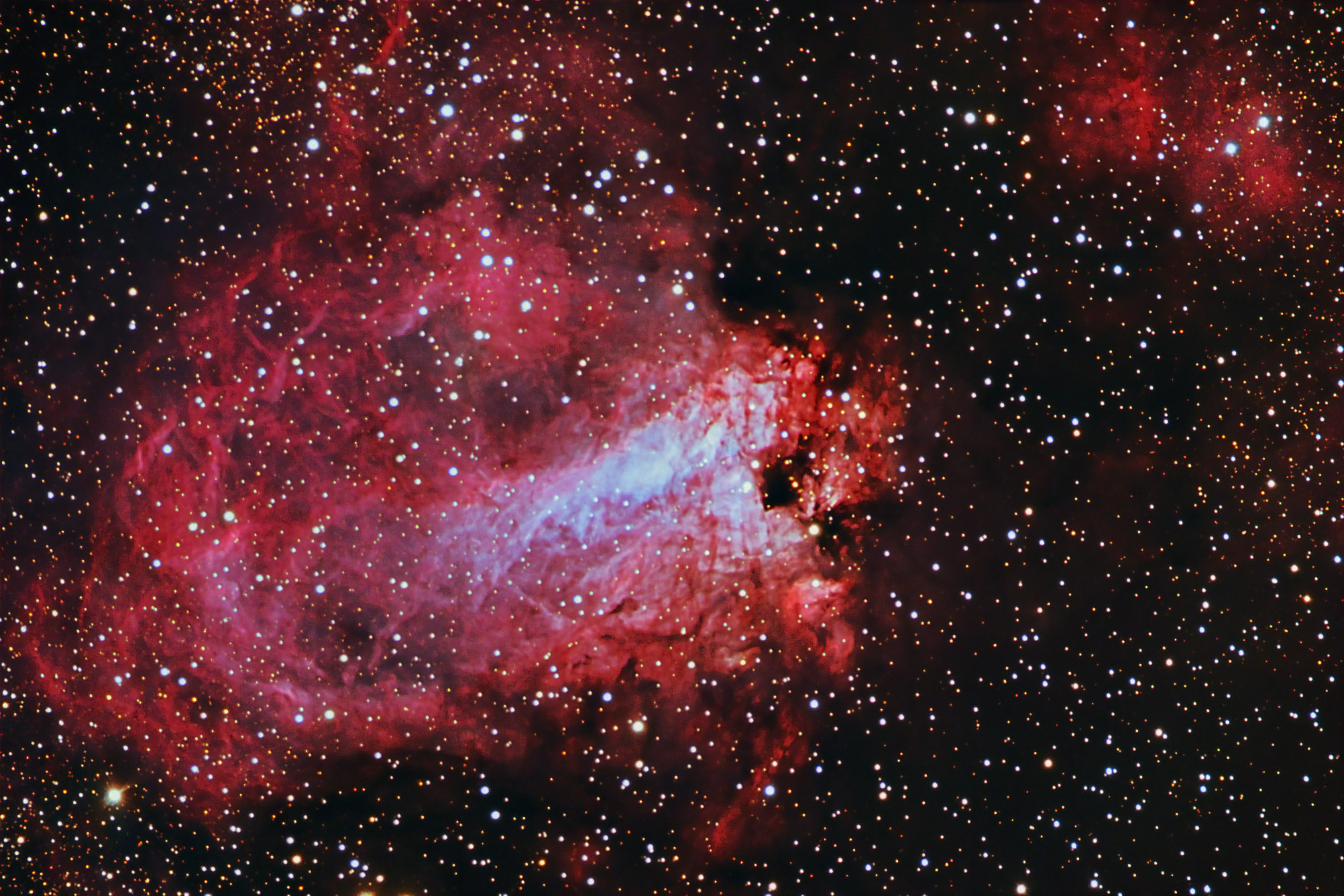
M17L12X5RGB3X5R2.JPG
| MO2001 104 is the core of a double planetary nebula. Technically it is the emission line star at the core of the nebula which goes by many designations. The name used by the best paper on it is KjPn 8 and the paper is at http://www.crya.unam.mx/rmaa/RMxAC..12/PDF/RMxAC..12_lopez.pdf . Other names include PK 112-00 1, K 3-89, and PN G112.5-00.1. Coordinates are 23h 24m 10.472s +62d 57' 30.75".
The apparent central star is actually a planetary nebula which is surrounded by a far larger planetary nebula. It is located in Cassiopeia on the southeast edge of the nebulosity surrounding the far more famous Bubble Nebula, the edge of which is seen to the upper right. It is also 40 minutes straight south of M52.
The paper concludes it is the result of a double star whose stars are so similar in evolution they both became bipolar planetary nebula at almost the same instant in astronomical time. The tiny one at the center having been created very recently, if you consider less than 3400 years recent. The large double cone-shaped nebula is thought to be 10 to 20 thousand years old according to the above paper. A somewhat deeper image of the nebula is seen in the paper.
For once I used H alpha data to assemble the image, 90 minutes of it in fact in 30 minute subs. This was combined 80% in red, 10% green and 20% blue as well as 100% in the luminance channel. All blended using lighten mode for the nebula only. Stars are pure LRGB.
14" LX200R @ f/10, Ha=3x30' L=4x10' RGB=2x10', STL-11000XM, Paramount ME | 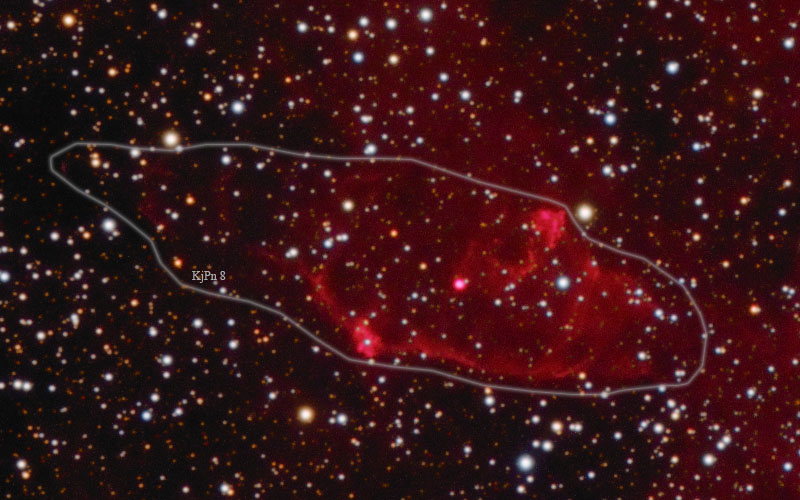
M02001-104ANNOTATED.JPG
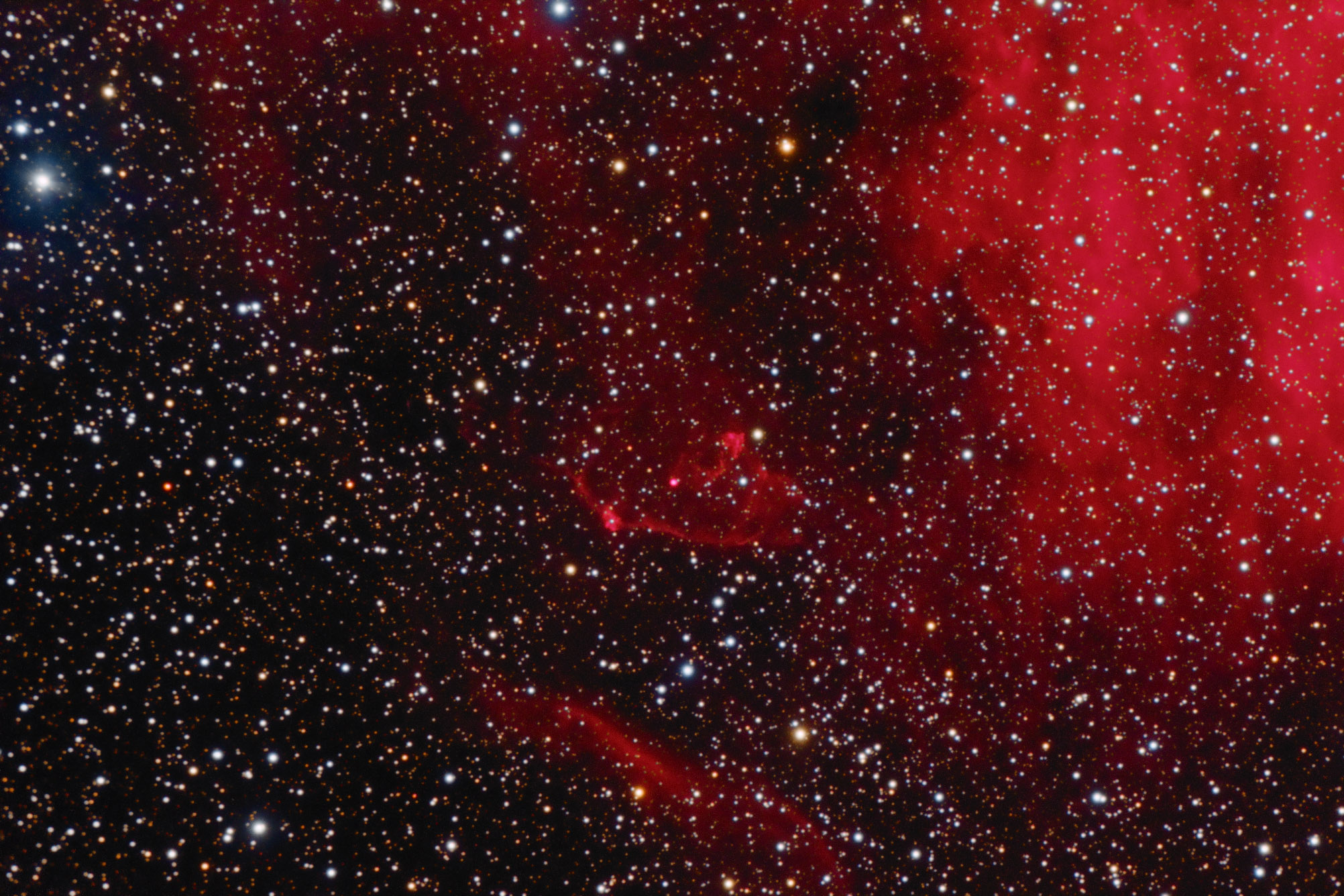
M02001_104L4X10HA3X30RGB2X10.JPG
| There seems little agreement on its size and distance. I've seen reports of 10,400 light-years to 8,500 light-years for its distance and 200 light-years to 50 light-years for its diameter. It appears the latter differences are due to how the edge of it is measured. Just the star ball would give the smaller diameter, including further stars would lead to a larger diameter. Since this one is located against the stars of the Milky Way, how you define its "edge" is extremely difficult. Still, the wide disagreement surprised me.
My image is rather poor. This object is located at about -24 degrees. My seeing goes to pot about by -15 degrees. I finally had an extremely good night so gave it a try. At higher declinations, stars were about 2" of arc in size or smaller in some cases but down low it was about 3.25". Far worse than I normally would process but likely the best I'll do from this location.
I'd hoped to see the planetary but only its central star shows. The nebula is lost in the large size of about 7" of the central star. It just won't show at my latitude, too much atmosphere to distort the image. It might show in an OIII image but I don't have that filter. It contains no hydrogen so H alpha is useless on this planetary. It's also strong in IR but my sensor has little IR sensitivity so that doesn't help either.
Stars are rather elongated due to atmospheric refraction. This low I really need to use a pseudo luminance image made from the RGB frames aligned to eliminate the chromatic refraction of our atmosphere this low. I did do that for the RGB part of this image. This resulted in smaller stars in the RGB image even though they were taken at 1.5" per pixel than I had in the luminosity image at 1" per pixel. But I took too few and too short RGB images to get a sufficient signal to noise ratio to use these as a pseudo luminosity image. I may go that route if I ever get a good enough night. Actually, it would take nights as I can only image this one for about 2 hours at best thanks to my Meridian Tree being in the way. I have an hour or so on either side of the tree before it gets so low seeing is really awful. If I could cut down the tree (that's illegal) I'd have nearly 4 hours of image time a night not 2 and those additional hours would be in the best seeing. Where are those beavers anyway?
Messier recorded this on in 1764 he credited its discovery to Abraham Ihle on August 26, 1665. Ihle left no records to help confirm this though he was a contemporary to Hevelius who got most of his information on new objects from Ihle and Hevelius did mention this globular. Others, including Halley and De Chéseaux, gave credit to Ihle as well. Though some in England claim it was the English astronomer Abraham Hill that first saw it and Messier spelled the name wrong. Few accept this idea, however.
14" LX200R @ f/10, L=6x5', RGB=2x10', STL-11000XM, Paramount ME | 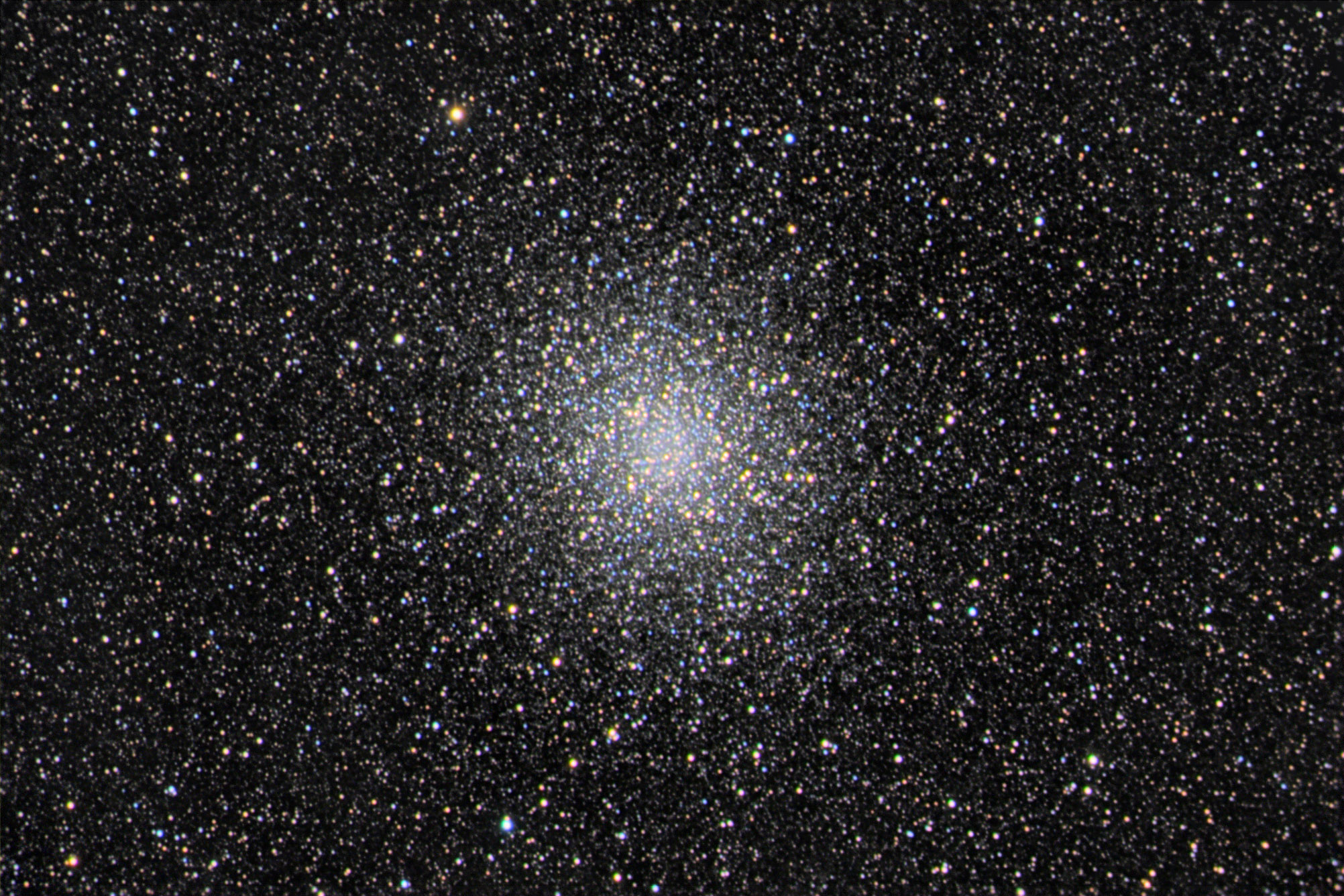
M22L6X5RGB2X10X3R.jpg
| M26 is an open star cluster in Scutum not far below much more famous M11. Its Trumpler class is I1m which means; detached with strong central condensation, star of nearly same brightness and 50 to 100 stars. I'm not seeing the first two in my image. Especially all stars being of about the same brightness. Maybe visually in a 6 to 8 inch telescope that might be the impression but it sure isn't what I see in my image. Other sources however disagree. I quoted the Sky Catalog 2000. Trumper himself says II2r saying it is less concentrated and stars are somewhat different brightness but there are more of them. Götz says II3m says it stars are even more far-ranging in brightness and we are back to 50 to 100 of them rather than more than 100. And you thought this was an exact science.
Like many M objects, this was taken before I really had any understanding of what I was doing. It is severely underexposed with one fourth the luminance data I'd use today and half the color data. Since the exposure times were only 5 minutes a frame the read noise is not buried in sky noise adding to the problems. Another I need to redo but likely never will. Compare my image to that of the NOAO image taken with this telescope, a bit larger than mine. http://pari.edu/wp-content/uploads/2016/04/Burrell-Schmidt-02364a.jpg Their best image https://www.noao.edu/image_gallery/images/d2/m26.jpg taken at about the same image scale as mine. One obvious difference is they left color natural. I tend to push colors somewhat to better distinguish the various star colors of clusters and bring out features in nebula and galaxies often lost due to insufficient color. Still, their image is more correct as to color saturation. Otherwise, they show little I don't. Again I severely underexposed my image. Apparently, they did too.
M26 is usually said to be about 5000 light-years distant and give an age of 85 to 90 million years making it a rather young cluster.
It was discovered by Charles Messier June 20, 1764.
14" LX200R @ f/10, LRGB=2x5', STL-11000XM, Paramount ME | 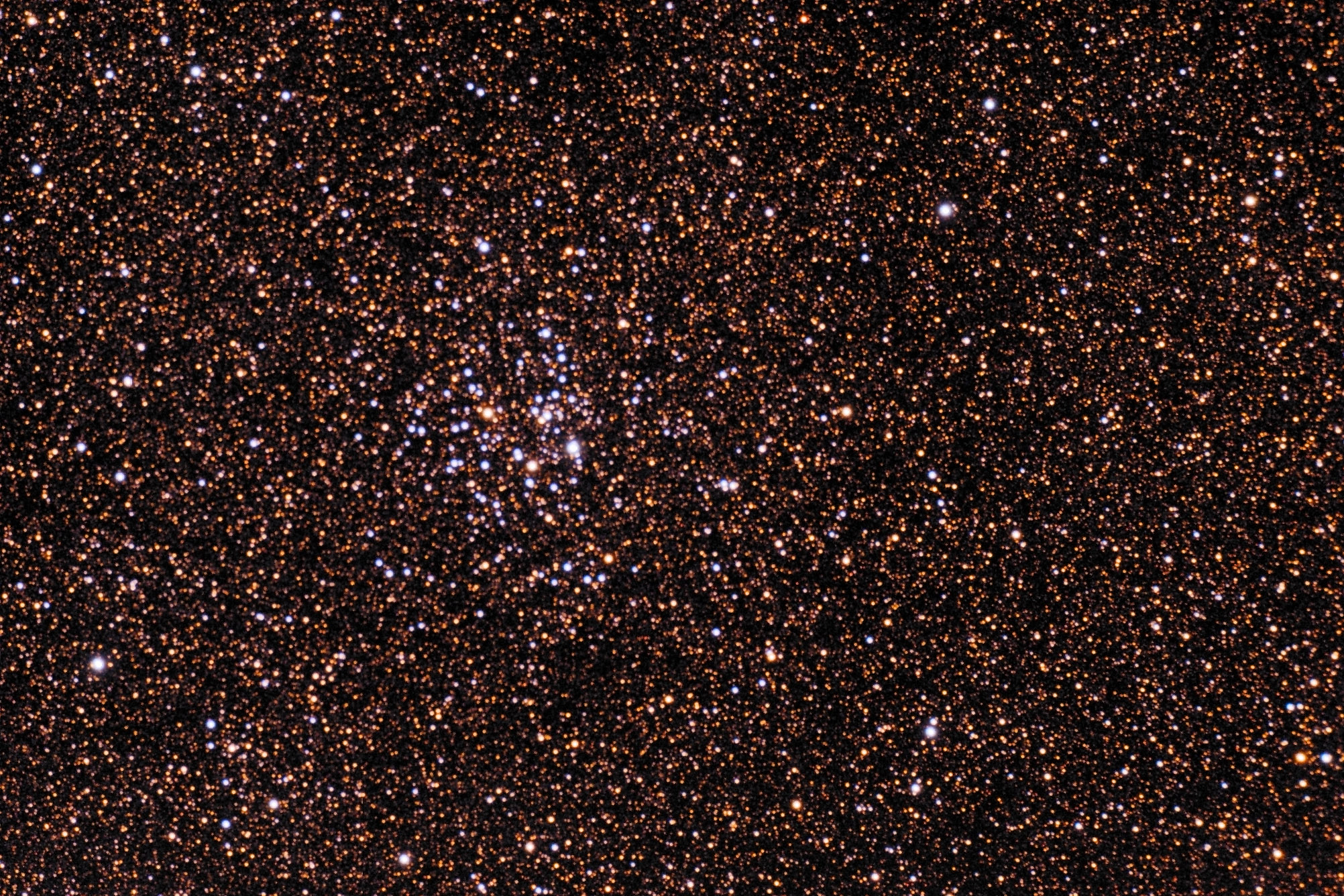
M26L2X5RGB2X5R1.JPG
| 











